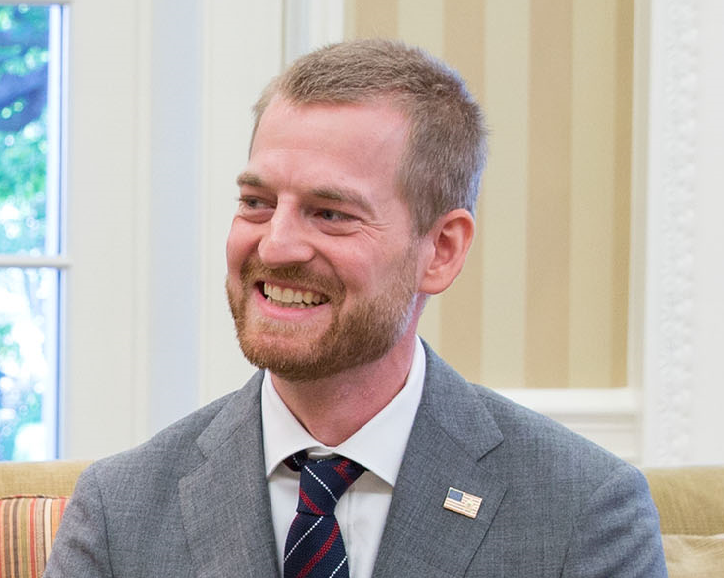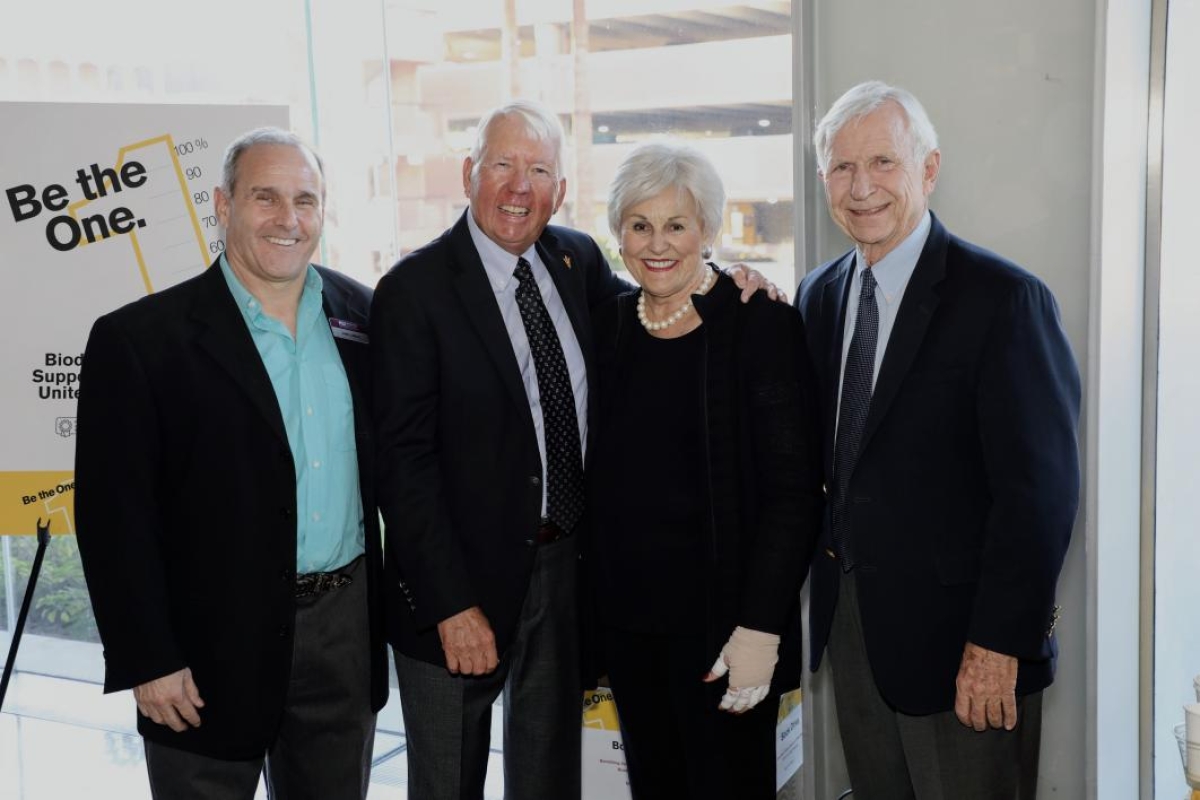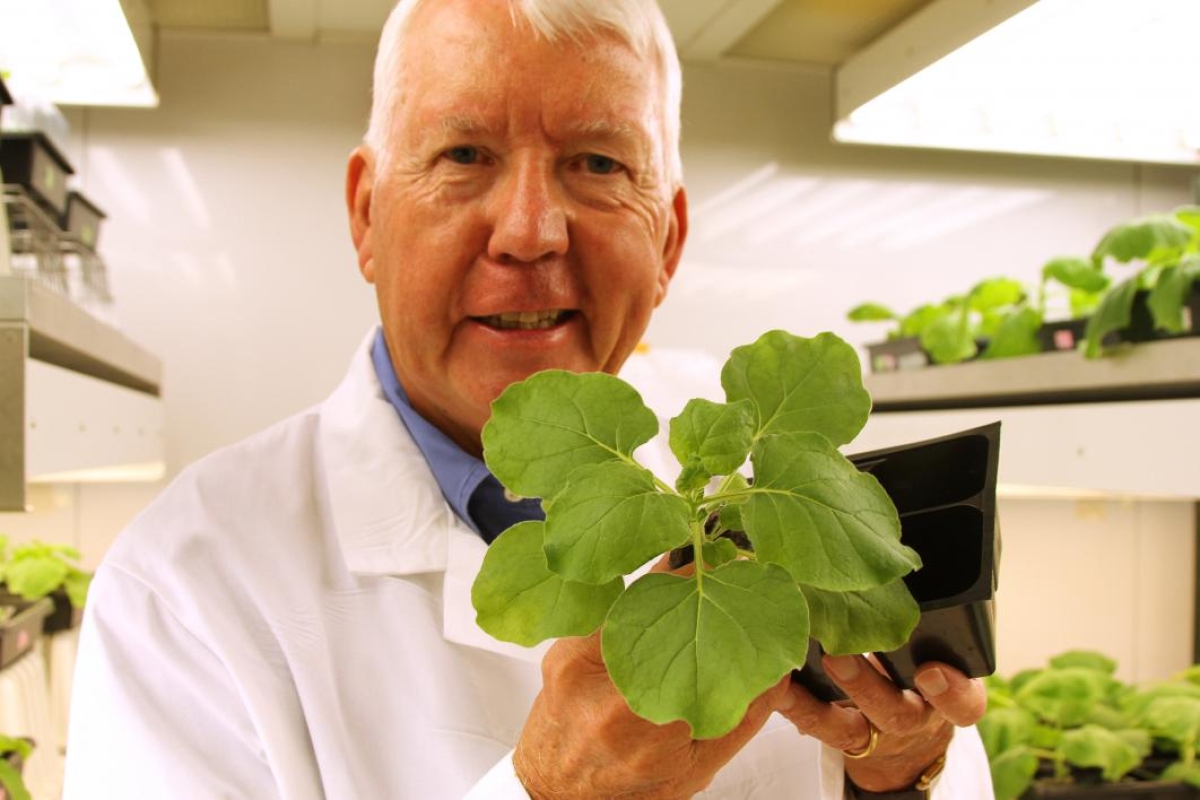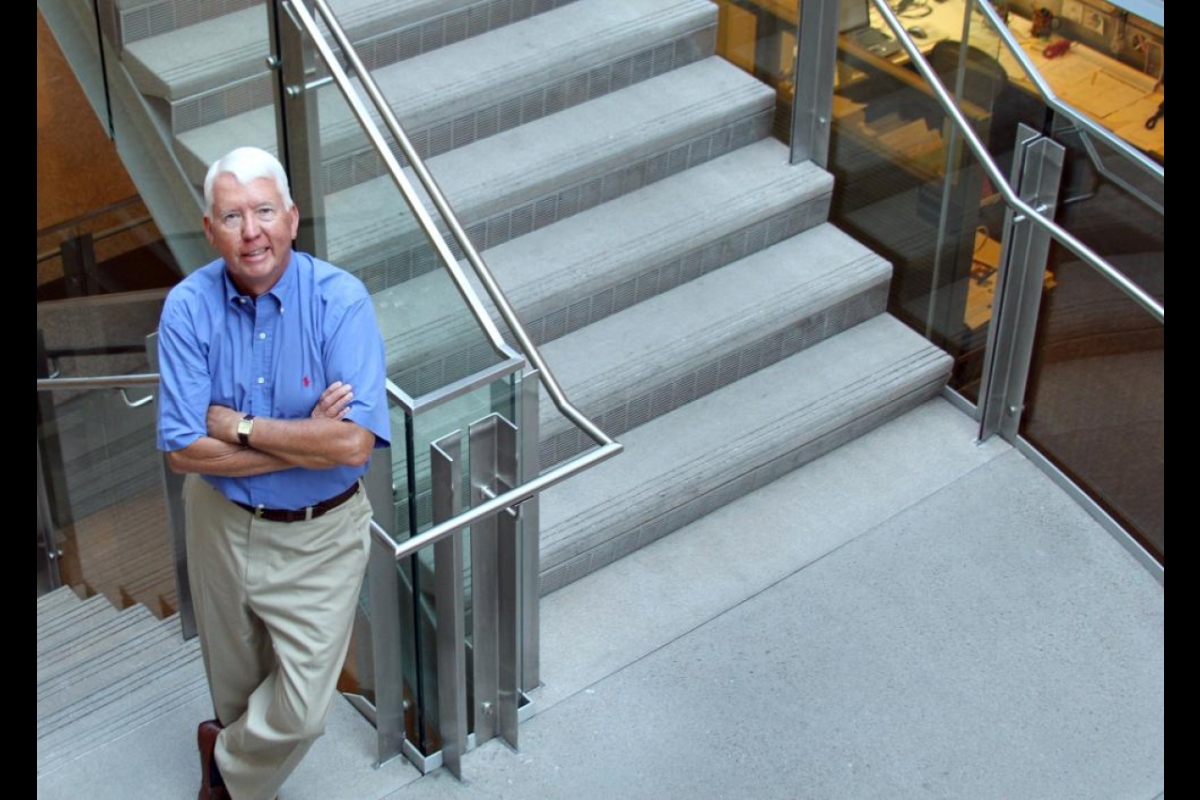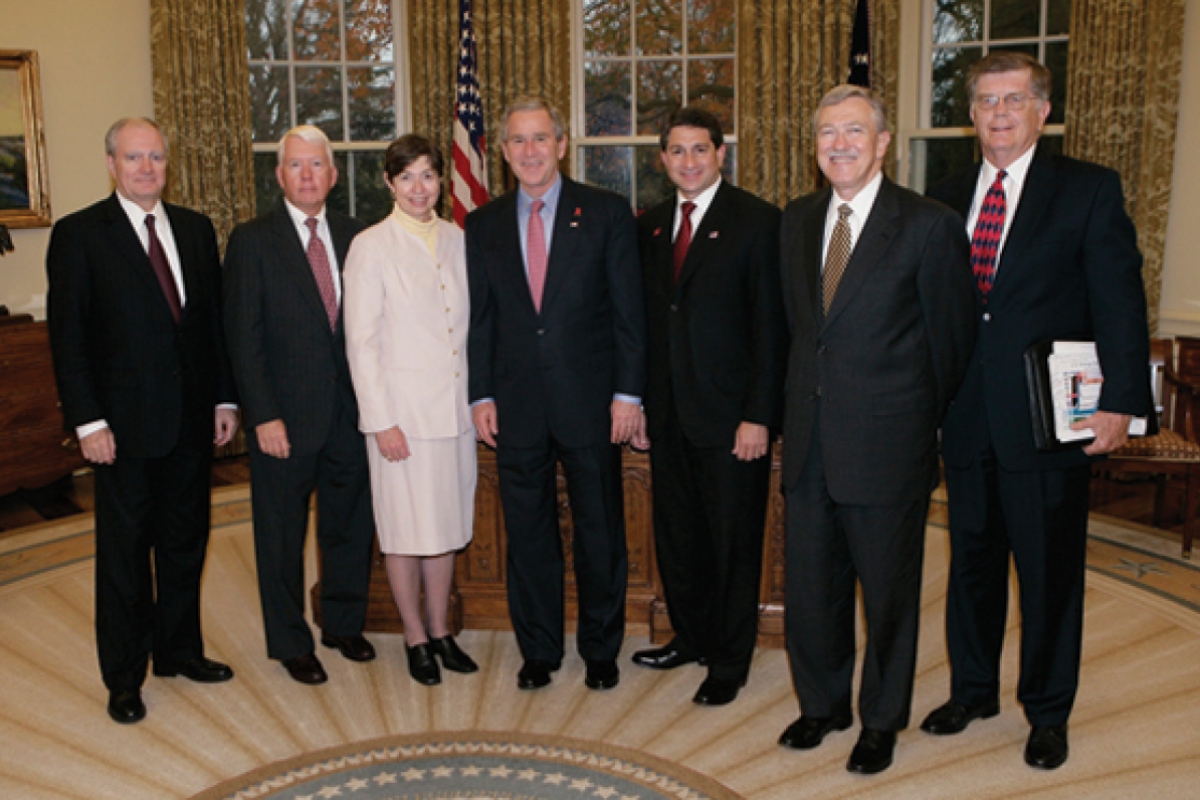Founding director of ASU’s Biodesign Institute, Charles Arntzen, retires

Charles Arntzen was honored by colleagues at his retirement celebration on Nov. 2.
From his roots as a fair-haired Minnesota farm boy to climbing the ladder of success in big pharma, to blazing a translational academic research path into life-saving therapies, Charles Arntzen has led one extraordinary life in science.
During the course of a prolific career, Arntzen and his collaborators have gained international recognition and helped burnish a special shine on ASU’s star with their dedicated efforts of using plants as biofactories for the production of life-saving vaccines and therapeutics.
For these achievements and his two decades of leadership at Arizona State University, Arntzen was honored by colleagues with a retirement celebration at the Biodesign Institute on Nov. 2.
“It’s been a creative wonderland within the Biodesign Institute that has allowed us to chase ideas that maybe initially, sounded a little crazy, but bring together the parts to make them a reality,” said Arntzen, who, among his many ASU titles, served as founding director of the Biodesign Institute, co-director of the Biodesign Center for Infectious Diseases and Vaccinology, the ASU Florence Ely Nelson Presidential Endowed Chair and a Regents’ Professor in the School of Life Sciences within the College of Liberal Arts and Sciences.
Ebola epidemic
One of those crazy ideas that turned into a career-crowning achievement for Arntzen was an academic, federal and industry collaboration that helped create an experimental drug called ZMapp that was used to treat U.S. aid workers infected with Ebola during the 2014 epidemic in West Africa.
“What does happen in biology, rarely but wonderfully when it happens, is the application of some aspect of research in a way that changes someone's life,” Arntzen said. “On Aug. 4, in 2014, that happened to me. And to be able to draw a straight line from a hypothesis to such a dramatic outcome is rare for a biological scientist like me. I'm still amazed but delighted.”
During the height of the Ebola outbreak, two American missionaries became infected. Physician Kent Brantly and health-care worker Nancy Writebol, both near death and desperate for help, became the first people to receive ZMapp, knowing full well that it had never been tested in humans before.
Kent Brantly
“In 2014, as I was dying from Ebola virus disease, I agreed to take an experimental drug called ZMapp,” Brantly said. “It seemed like a last resort in my fight against the infection.”
Within 24 hours after taking ZMapp, Brantly went from death’s door to walking again, and both Writebol and Brantly fully recovered.
“Since my recovery, I've had the chance to learn the miraculous history of this drug's development,” Brantly said.
“I'm grateful for the role the Biodesign Institute at ASU has played in the discovery process and in forging ties to industry collaborators who translated new ideas into the product that I received. And upon the occasion of his retirement,” Brantly said, “I offer my sincerest thanks to Charles Arntzen for his pioneering role in establishing plant-made manufacturing and especially for ZMapp. The importance of lifesaving medications cannot be overstated, a lesson I have learned firsthand!”
For his leadership role in developing ZMapp, Arntzen was nationally recognized in 2015 as the No. 1 honoree with Fast Company’s annual “100 Most Creative People in Business.” Closer to home, Arntzen received the 2014 Arizona Bioscience Researcher of the Year award, given annually to the researcher who has made the most significant contributions to Arizona bioscience advancement.
“Charlie Arntzen has been one of the most important faculty members in the history of this university. He’s a person who can think, connect, drive, create and link ... do all of that in the spirit of a scientist in either a corporate or university setting.”
— ASU President Michael Crow
A fertile mind
Little was known of ZMapp at the time of the epidemic, but since then, the world has learned how it originally sprung from the minds of creative scientists like Arntzen and his collaborators more than a decade ago at ASU’s Biodesign Institute.
“Charlie Arntzen has been one of the most important faculty members in the history of this university,” said ASU President Michael Crow. “He’s a person who can think, connect, drive, create and link … do all of that in the spirit of a scientist in either a corporate or university setting.
“Most importantly, one thing I know from working with him, is that nothing is impossible. Anything that you can imagine ... let’s see if we can take viruses that attack animals, embed these viruses genetically into plants, have these animals, humans or others ingest these plants and then be vaccinated from these viruses. Who thought that up? Someone in a science fiction story? No. Arntzen. He thought it up.”
ZMapp is a serum made in a plant with a notorious reputation as a killer, tobacco. The pathway from discovery to treatment began with an idea Arntzen had to produce low-cost vaccines in plants to fight devastating infectious diseases in the developing world.
On a trip to Thailand, Arntzen witnessed a mother soothing a hungry infant by placing a mashed banana on the baby’s lips. He wondered if plants could be a brand-new route for his research, by developing orally delivered or “edible vaccines” from fruits like bananas.
But after spending a decade formulating vaccines in bananas, tomatoes and even potatoes, his team had to veer from that initial idea. It simply took too long to grow the plants (up to three years for bananas) and it was too tough a hurdle to control the dosage from a fruit to pass FDA guidelines.
Now, they focus on making purified plant extracts from quick-growing, leafy tobacco plants (which have a very high yield) containing the vaccine or therapeutic of interest (from plants that are only a few weeks old).
This is how ZMapp is currently made.
The best defense
After 9/11 and the anthrax attack on the U.S. Senate, the government invested heavily in biodefense, including $3.7 million to Arntzen and a small San Diego-based startup called Mapp Biopharmaceutical, led by Larry Zeitlin and Kevin Whaley.
The goal was to develop defenses against pathogens, including Ebola, that could be used as potential biological threats.
“I think the real gain is from all of the money that was invested early on — our work dates back to 2002 — and it takes a long time to build up that core competency that is necessary for drug development,” Arntzen said. “This has happened for both vaccines and therapeutics in academia and companies. We should give credit to funding agencies like DARPA and NIH for giving us the tools that we need.”
With a dream team of collaborators, they modified the tobacco plants to produce a protective cocktail made of three monoclonal antibodies. In work published in 2014, this therapeutic cocktail proved to be 100 percent effective in protecting animals against Ebola, even five days after onset of infection.
“We’ve been teaming together manufacturing innovation, tobacco engineering innovation, our virus work and antibody discoveries,” Arntzen said. “I’m guessing, just in the development of ZMapp, there were about 100 different people with many different skills who came together.”
ZMapp is the leading therapeutic to fight Ebola, but because it was experimental, there were only enough doses to save a few during the 2014 outbreak. In response, the government has awarded a multimillion-dollar contract to Mapp for the massive scale-up desperately needed to stockpile enough of the drug and safeguard against another possible outbreak.
Now, commercial partner Kentucky BioProcessing has produced enough ZMapp for testing in future clinical trials to help optimize the study of how ZMapp works to fight Ebola.
The godfather of pharming
His research as a scientist at the ASU Biodesign Institute has put Arizona on the map in new ways, as people all over the world are fascinated by the idea that it is possible to produce modern protein drugs inside a plant.
The discovery that tobacco plants could be medicine-machines earned Charlie the title of the “godfather of pharming.” In other words, he was “farming” plants in a way that would turn them into medicines — also known as “farmaceuticals.”
These have included plant-based anti-cancer agents, therapeutic agents to protect populations from bioterror threats, proteins to combat rabies, plant-derived vaccines against Hepatitis C, noroviruses and many infectious diseases.
Arntzen's longstanding ASU research team, which includes Tsafrir Mor, Hugh Mason, Qiang “Shawn” Chen and many others, has been a pioneer in producing pharmacologically active products in transgenic plants, overcoming health and agricultural constraints in the developing world as well as the use of plant biotechnology for enhancement of food quality and value.
“Most scientists only plow in one plot,” Mor said. “So few transcend the disciplines as Charlie Arntzen did. Thank you for allowing me to go bananas with you, and being part of this exciting time.”
Together, they will carry on Arntzen’s quest to pursue plant-based vaccines and therapeutics to combat West Nile virus, dengue fever, nerve agents and even cancer.
ASU leadership
Arntzen was recruited to ASU from Cornell, where he served as president and CEO of the Boyce Thompson Institute for Plant Research.
“Charlie joined us in August of 2000, and little did we know that it was such an inflection point for this university,” said Lattie Coor, ASU president from 1990–2002. “Everything I saw when I got here was that this university was already better than it knew it was, but this message hadn’t reached the rest of the world. Once we determined where our strengths were, we began looking actively on how we could build out a better, stronger research platform for the university.
“Charlie was the very first member of the National Academy to join as an ASU faculty. He paved the way for ASU in that kind of pioneering fashion that he showed.”
Arntzen was elected to the prestigious U.S. National Academy of Sciences in 1983. He is known throughout the scientific community for his basic research contributions to plant structure and function and increasing the efficiency of plant photosynthesis for agricultural improvements.
“My research career evolved over 40 years, but always focused on basic research in plant molecular biology and protein engineering, with a goal of enhancing food quality and value,” Arntzen said.
In the late 1980s, he left academia to work as director of plant science and microbiology in DuPont's agricultural products division, where he gained valuable expertise in bringing crop biotechnology to the market, with a focus on herbicide and insect resistance to help boost crop yields.
Once at ASU, he and Coor put together plans to bundle a new source of state funding, the voter-approved Proposition 301 sales tax, into supporting the growth of ASU research in a new interdisciplinary concept of nature-inspired research called the Biodesign Institute.
Their guiding principles were to move away from individual investigators and use multidisciplinary teams to tackle the world’s biggest challenges, with much closer ties to industry to translate groundbreaking discoveries to benefit Arizonans and beyond.
“We wanted to put these components into practice, that as a team, we could never do as individual researchers,” Arntzen said.
Arntzen served as the founding director of the Biodesign Institute (originally called AzBio) until May 2003, and as co-director of Biodesign’s Center for Infectious Diseases and Vaccinology until 2007.
Arntzen was also the director of two NIH-funded cooperative research centers at ASU, working on the development of hepatitis C vaccines and vaccines and microbicides to prevent sexually transmitted infections.
Arntzen’s early, big science team pursuits set the tone for the massive expansion of ASU research, and for the more than 400 creative scientists and students now at the Biodesign Institute who continue to produce groundbreaking discoveries.
These include: linking gut microbial composition to autism, identifying diseases like cancer at their earliest stages, generating renewable energy and making polluted water and soil clean, all with the goal of advancing global health, energy and the environment.
Most recently, the Biodesign Institute capped another fiscal year with almost $40 million in annual research expenditures, and approaching nearly $700 million in research funding since the bright early days of Biodesign under Arntzen’s leadership.
Since its inception, Biodesign Institute scientists have disclosed nearly 700 inventions, resulting in 97 patents, 53 licensing agreements and 22 spin-out ventures. In its first full decade of operations, Biodesign has had a $1.5 billion impact on the regional economy and supported more than 3,000 jobs. Researchers at the institute currently are studying more than 100 diseases, including cancer, diabetes, Alzheimer’s disease, immune disorders and infectious diseases.
With their game-changing approach to breaking traditional boundaries between biology, chemistry, physics, computing, engineering and mathematics, Biodesign scientists have launched such new technologies as the world’s first mobile metabolism tracker, an effective treatment for Ebola, a $1 diagnostic for Zika, systems for turning algae into clean energy and a diagnostic platform that can detect some 90 diseases with a single drop of blood.
“Thank you for all that you have done for ASU,” Crow said. “For getting Biodesign off the ground, and most importantly for helping us understand that human beings, when they connect to nature and they understand nature, can really do anything.”
National leadership
Throughout his career, Arntzen has also served the nation through science societies and policy.
Arntzen provided expertise and national service from 2001–2008 on the President’s Council of Advisers on Science and Technology (PCAST). This policy panel met with former President George W. Bush and members of his administration to provide technical summaries and proposals for advancing the U.S. research capacity and economic growth. As part of PCAST, Arntzen made significant contributions to multiple reports, including biodefense. These reports were the basis of many budget proposals, including the successful establishment of the federal Project Bioshield and expanded university research funding.
Arntzen was selected by the American Society of Plant Biologists (ASPB) to receive the inaugural fellow of ASPB Award and the Botanical Society of America Centennial Award in 2007. The 2007 fellow of ASPB Award was granted for: “recognition of distinguished and long-term contributions to plant biology and service to the Society by current members in areas that include research, education, mentoring, outreach and professional and public service.”
He is a fellow of the American Association for the Advancement of Science (AAAS) and also of the American Society of Plant Biologists, and a member of the National Academy of Inventors. He received the Award for Superior Service from the U.S. Department of Agriculture for international project leadership in India 1980, and the American Society of Plant Biology Leadership in Science Public Service Award in 2004.
Forging ahead
An avid golfer, nature photographer and global traveler, Arntzen will now have ample opportunity to take advantage of Arizona’s year-round sunshine and enjoying life with his wife, Kathy, his son's family and especially his grandchildren.
Yet he’ll still keep an advisory role, hoping to help ASU’s plant experts and his academic family with bringing more vaccines and therapeutics to the market.
“I have been fortunate to work with a wonderful team of people at ASU, and with companies with extraordinary and complementary skills at Mapp, ICON and KBP,” Arntzen said. “I am not yet ready to quit just yet, as I believe that a plant-made norovirus vaccine will only come if we can find a formulation that will work, and we still have ongoing research with that goal in mind.”
Due to the Ebola epidemic of 2014 — and continued concern about the spread of newly emerging dangerous viruses — the number of scientists and pharmaceutical companies interested in finding cost-effective new vaccines and drugs is expanding.
Arntzen will cheer on the continued developments in the use of plants as “medicine machines” and trying to save many more lives, particularly in developing world.
“In my mind, ZMapp has been a success both as a medicine and to show that ‘pharming’ works,” Arntzen said.
“I’m happy to retire, but will certainly keep watching what you do.”
More Science and technology

NASA launches space telescope to chart the sky and millions of galaxies
California’s Vandenberg Space Force Base was the site for Tuesday’s 8:10 p.m. launch of the NASA SPHEREx mission aboard a SpaceX…

ASU-led Southwest Sustainability Innovation Engine funds 8 promising tech startups
In the startup world, tech companies often fall victim to what’s known as the “valley of death” — the gap between technological…

New study explores the link between diet, blood sugar and cancer risk across species
Researchers have long known that diet exerts a profound influence on health, including the risk of developing cancer. A new study…
